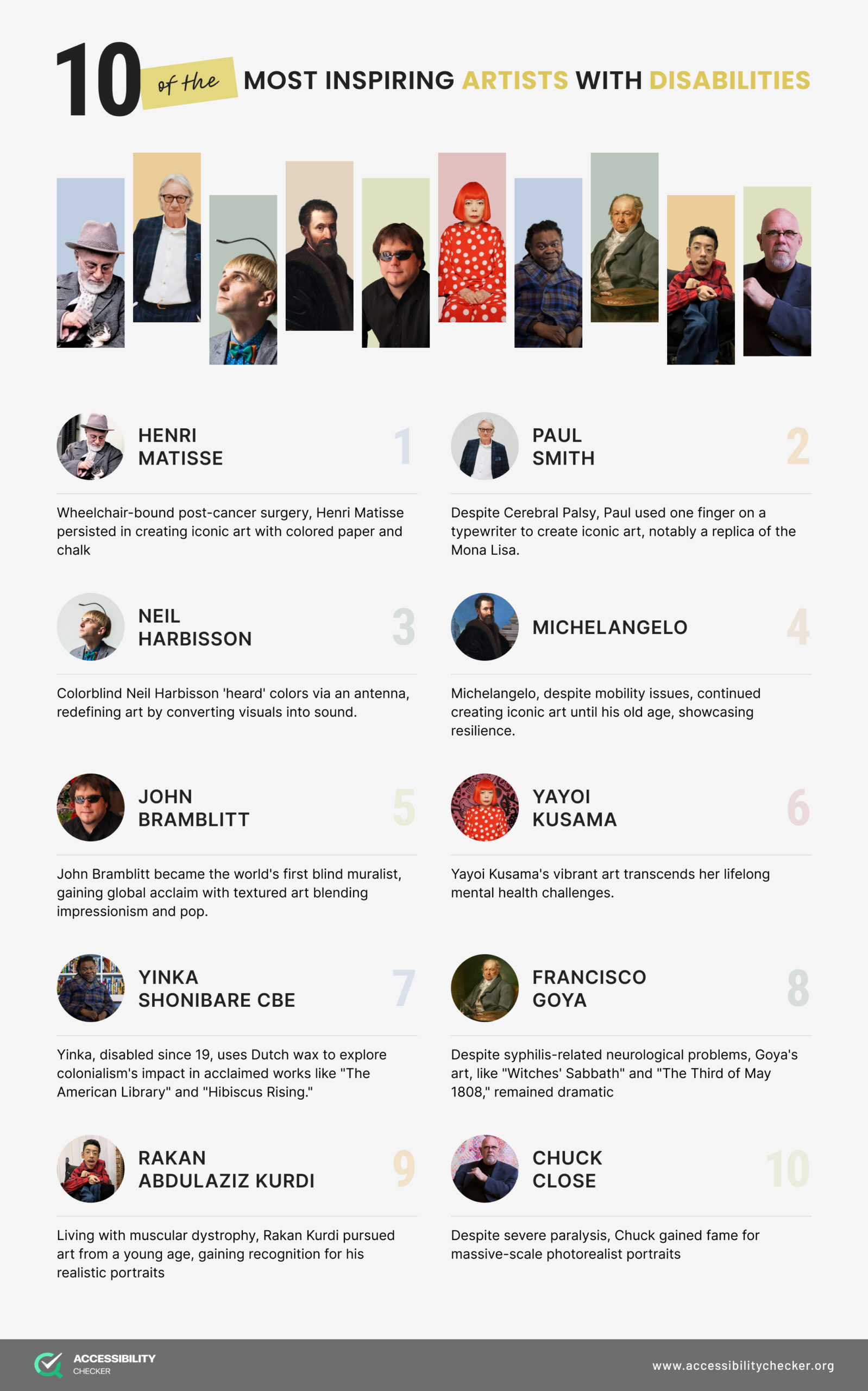Empowering Creativity: 10 Artists with Disabilities
Art has shaped our world for centuries, with countless artists inspiring us with their skills and creativity every day. However, what you may not know is that a number of famous artists were and still are living with a disability.
These artistic geniuses are a testament to the fact that creativity can still flourish, regardless of internal or external circumstances.
In this blog, we celebrate a handful of some of the most inspiring disabled artists of our time.

These artists are just a few of the many creatives around the world who didn’t view their disabilities as limitations.
1. Henri Matisse
Following a surgical procedure for cancer, Henri Matisse became wheelchair-bound. However, this didn’t stop him from pursuing his dreams of bringing his creations to the world. In fact, he believes that his disability gave him a new lease on life.
As Henri discovered a newfound beauty around him, he started creating art out of colored paper shapes, which his assistant would help him stick down. Chalk is another one of his preferred mediums.
Even though he passed away in 1954, some of his most famous pieces are still well-known around the world, including Le bonheur de vivre, Blue Nudes, The Green Stripe, and Music.
2. Paul Smith
Born with Cerebral Palsy, Paul used one finger on a typewriter to create outstanding works of art throughout his lifetime. His speech, mobility, and fine motor skills were all impacted, yet he still managed to pursue a career that he loved.
At the young age of 11, Paul discovered a passion for creating typewriter art when he started playing around with a typewriter that was thrown out by a neighbor. He turned this simple tool into an outlet, allowing him to express himself and convey his feelings.
One of his most famous pieces is a replica of the Mona Lisa.
3. Neil Harbisson
Neil Harbisson was born without the ability to see colors, something you would think is essential for an artist, but this didn’t stop him.
Instead, Neil attached a special antenna to his head that enabled him to ‘hear’ colors, enhancing what he was capable of seeing naturally. He was even able to see infrared and ultraviolet light.
The result was that he was able to turn music and images into sounds he could hear, putting a new spin on artistic expression.
4. Michelangelo
Famously known for his painting on the ceiling of the Sistine Chapel, Michelangelo is one of the most famous painters and sculptures of our time. However, what many don’t know is that he struggled with gout and osteoarthritis.
He regularly had trouble using his hands and experienced pain almost daily, which limited his mobility. Yet, he still managed to bring countless works of art to the world, chiseling and painting until he was over 80 years old.
The reality is even though he has mobility issues, one of the best things he could’ve done is to keep moving, which may explain why he was still creating art long into his old age.
5. John Bramblitt
Even though John Bramblitt is functionally blind, making it difficult to distinguish between light and dark, he still managed to become the first bling muralist in the world.
John’s blindness is a result of complications due to epilepsy. He had his first seizure at the age of 2 and completely lost his sight by the age of 31.
Today, John uses textured paint to navigate each canvas he works on, creating pieces that mix impressionism with modern pop art. His art has been sold in over 120 countries and he has even appeared internationally in print, TV and radio.
6. Yayoi Kusama
Known for her bright and inspiring works of art, Japanese artist Yayoi Kusama has battled mental health issues all her life. Along with having obsessive-compulsive disorder, Yayoi also experiences regular hallucinations.
Instead of letting her mental illness slow her down, she turned to bright colors and repetitive shapes to take her mind into a meditative state.
Even though Yayoi has been voluntarily living in a psychiatric facility since the late 1970s, she is still one of the most successful disabled artists living today.
7. Yinka Shonibare CBE
After contracting a rare infection at the age of 19, Yinka was left physically disabled and reliant on a wheelchair. Today, he is widely known for his paintings, sculptures, photography, and film projects, all of which are linked to the connection between colonialism and our modern world.
Dutch wax is one of his preferred mediums, which gives his art more depth and brings his stories to life. Some of his most famous works include The American Library, Hibiscus Rising, and Woman Shooting Cherry Blossoms.
8. Francisco Goya
Famous Spanish painter Francisco Goya experienced a number of neurological problems throughout his life, much of which was attributed to syphilis. Headaches, dizziness, vision, and hearing problems were all a part of his daily life. At one point, he even started experiencing mobility issues in his right arm.
Even through his illness, which brought on long periods of depression, Francisco continued to paint, with his creations becoming even more imaginative and dramatic as he got older.
Instead of letting his disabilities hinder him, he brought works such as Witches’ Sabbath, The Clothed Maja, The Dog, and The Third of May 1808 to the world.
9. Rakan Abdulaziz Kurdi
Rakan Kurdi, a young Saudi artist living with muscular dystrophy used a physical challenge to motivate him to pursue a career he loves.
Rakan started drawing at just 8 years old when he began attending the Disabled Children’s Association school. This is also where his educators encouraged him to keep pursuing art.
Today, he is known for his realistic portraits, with one of his most notable works being a portrait of Sheikh Zayed. Rakan draws for at least two hours per day to keep improving his skills and regularly accepts custom orders from across the country.
10. Chuck Close
Despite having severe paralysis, Chuck Close became famous for his massive-scale photorealist and abstract portraits of himself and others. Throughout his childhood, he honed his artistic skills through private art lessons, drawing and painting from live models.
It was later in life that he found his unique take on art. Chuck transposed his subjects from photographs into visual data organized by gridded compositions, creating realistic, one-of-a-kind pieces.
Chuck is another example of an artist who adapted his skills to overcome his disability, proving that physical limitations do not need to hinder creativity.
Final Thoughts
There are so many artists around the world who are choosing to move past their disabilities to pursue hobbies and careers that they’re passionate about. ‘
And this doesn’t end at painters and sculptures either – there are countless other musicians, actors, and dancers who are living with disabilities too.
We hope this list of artists has inspired you and made you realize that anything is possible if it’s what you really want.


